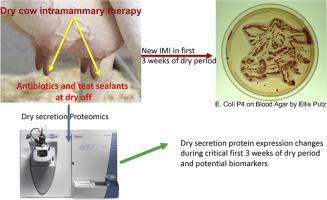当前位置:
X-MOL 学术
›
J. Proteomics
›
论文详情
Our official English website, www.x-mol.net, welcomes your feedback! (Note: you will need to create a separate account there.)
Characterization of bovine mammary gland dry secretions and their proteome from the end of lactation through day 21 of the dry period.
Journal of Proteomics ( IF 3.3 ) Pub Date : 2020-05-18 , DOI: 10.1016/j.jprot.2020.103831 Timothy A Reinhardt 1 , John D Lippolis 1
Journal of Proteomics ( IF 3.3 ) Pub Date : 2020-05-18 , DOI: 10.1016/j.jprot.2020.103831 Timothy A Reinhardt 1 , John D Lippolis 1
Affiliation

|
The dry period in dairy cows is critical to mammary health. We used label-free mass spectroscopy to quantify whey proteins from milk/dry secretions collected on days 0, 3,10, and 21 of the dry period. The number of proteins identified was 776. The number of proteins upregulated at one or more times in the dry period was 109. The most significant enriched Gene Ontology (GO) terms for the upregulated proteins were immune function and stress-related. The number of proteins that are downregulated in the dry period was 68. The most significant enriched GO terms for the down-regulated proteins were stress and immune function related. In other assays, total protein and lactoferrin concentrations rose significantly by days 10 and 21 of the dry period. We then examined day 21 dry secretions for their ability to inhibit bacterial growth. Bacterial growth inhibition did not correlate with lactoferrin for 4 coliforms tested nor for all 7 mastitis pathogens tested. Eleven proteins out of the total number of proteins identified were significantly associated with positive or negative coliform growth in day 21 dry secretions. The dry secretion protein composition changes we found may provide new information for understanding the dry period and indirectly involution. BIOLOGICAL SIGNIFICANCE: The dry period in a cow is critical to the success of a cow's subsequent lactation for many reasons. Of particular importance is the rate of establishment of new intramammary infections (IMI), which is significant in the dry period. IMI susceptibility is most significant in the first few weeks of the dry period. There are both physical and mechanical reasons for increased IMI susceptibility in the first few weeks of the dry period. We also know that dry secretions have high levels of antimicrobial proteins and bacterial growth is diminished in dry secretions compared to milk. However, we found that by day 21 of the dry period, antimicrobial proteins, such as lactoferrin, are no longer correlated with reduced bacterial growth in dry secretions. We established a dry secretion proteome for the first 3 weeks of the dry period. The library of proteins in dry secretions presented provides a better understanding of the critical dry period in dairy cow management.
中文翻译:

从泌乳结束到干奶期第 21 天,牛乳腺干性分泌物及其蛋白质组的表征。
奶牛的干奶期对乳房健康至关重要。我们使用无标记质谱法来量化在干燥期的第 0、3、10 和 21 天收集的牛奶/干燥分泌物中的乳清蛋白。鉴定的蛋白质数量为 776。在干旱期一次或多次上调的蛋白质数量为 109。上调蛋白质的最重要的富集基因本体 (GO) 术语是免疫功能和压力相关。在干旱期下调的蛋白质数量为 68。下调蛋白质的最显着富集的 GO 术语与压力和免疫功能相关。在其他测定中,总蛋白和乳铁蛋白浓度在干燥期的第 10 天和第 21 天显着上升。然后我们检查了第 21 天的干分泌物抑制细菌生长的能力。对于测试的 4 种大肠菌群和测试的所有 7 种乳腺炎病原体,细菌生长抑制与乳铁蛋白无关。鉴定出的蛋白质总数中有 11 种蛋白质与第 21 天干分泌物中的阳性或阴性大肠菌群生长显着相关。我们发现的干分泌蛋白组成变化可能为理解干湿期和间接退化提供新的信息。生物学意义:出于多种原因,奶牛的干奶期对于奶牛后续泌乳的成功至关重要。特别重要的是新的乳房内感染 (IMI) 的发生率,这在干燥期很重要。IMI 易感性在干燥期的前几周最为显着。在干燥期的前几周,IMI 易感性增加有物理和机械原因。我们还知道,与牛奶相比,干性分泌物含有高水平的抗菌蛋白,并且干性分泌物中的细菌生长减少。然而,我们发现到干燥期的第 21 天,乳铁蛋白等抗菌蛋白不再与干燥分泌物中细菌生长减少相关。我们在干燥期的前 3 周建立了干燥分泌蛋白质组。所呈现的干燥分泌物中的蛋白质库提供了对奶牛管理中关键干燥期的更好理解。我们发现,到干燥期的第 21 天,乳铁蛋白等抗菌蛋白不再与干燥分泌物中细菌生长减少相关。我们在干燥期的前 3 周建立了干燥分泌蛋白质组。所呈现的干燥分泌物中的蛋白质库提供了对奶牛管理中关键干燥期的更好理解。我们发现,到干燥期的第 21 天,乳铁蛋白等抗菌蛋白不再与干燥分泌物中细菌生长减少相关。我们在干燥期的前 3 周建立了干燥分泌蛋白质组。所呈现的干燥分泌物中的蛋白质库提供了对奶牛管理中关键干燥期的更好理解。
更新日期:2020-05-18
中文翻译:

从泌乳结束到干奶期第 21 天,牛乳腺干性分泌物及其蛋白质组的表征。
奶牛的干奶期对乳房健康至关重要。我们使用无标记质谱法来量化在干燥期的第 0、3、10 和 21 天收集的牛奶/干燥分泌物中的乳清蛋白。鉴定的蛋白质数量为 776。在干旱期一次或多次上调的蛋白质数量为 109。上调蛋白质的最重要的富集基因本体 (GO) 术语是免疫功能和压力相关。在干旱期下调的蛋白质数量为 68。下调蛋白质的最显着富集的 GO 术语与压力和免疫功能相关。在其他测定中,总蛋白和乳铁蛋白浓度在干燥期的第 10 天和第 21 天显着上升。然后我们检查了第 21 天的干分泌物抑制细菌生长的能力。对于测试的 4 种大肠菌群和测试的所有 7 种乳腺炎病原体,细菌生长抑制与乳铁蛋白无关。鉴定出的蛋白质总数中有 11 种蛋白质与第 21 天干分泌物中的阳性或阴性大肠菌群生长显着相关。我们发现的干分泌蛋白组成变化可能为理解干湿期和间接退化提供新的信息。生物学意义:出于多种原因,奶牛的干奶期对于奶牛后续泌乳的成功至关重要。特别重要的是新的乳房内感染 (IMI) 的发生率,这在干燥期很重要。IMI 易感性在干燥期的前几周最为显着。在干燥期的前几周,IMI 易感性增加有物理和机械原因。我们还知道,与牛奶相比,干性分泌物含有高水平的抗菌蛋白,并且干性分泌物中的细菌生长减少。然而,我们发现到干燥期的第 21 天,乳铁蛋白等抗菌蛋白不再与干燥分泌物中细菌生长减少相关。我们在干燥期的前 3 周建立了干燥分泌蛋白质组。所呈现的干燥分泌物中的蛋白质库提供了对奶牛管理中关键干燥期的更好理解。我们发现,到干燥期的第 21 天,乳铁蛋白等抗菌蛋白不再与干燥分泌物中细菌生长减少相关。我们在干燥期的前 3 周建立了干燥分泌蛋白质组。所呈现的干燥分泌物中的蛋白质库提供了对奶牛管理中关键干燥期的更好理解。我们发现,到干燥期的第 21 天,乳铁蛋白等抗菌蛋白不再与干燥分泌物中细菌生长减少相关。我们在干燥期的前 3 周建立了干燥分泌蛋白质组。所呈现的干燥分泌物中的蛋白质库提供了对奶牛管理中关键干燥期的更好理解。


























 京公网安备 11010802027423号
京公网安备 11010802027423号